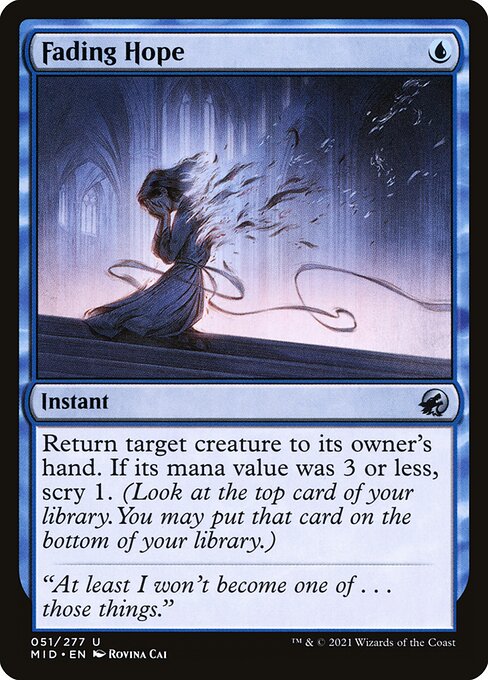
Image courtesy of Scryfall.com
Blue’s Lean, Mean Tempo: Low-Cost Synergy Playstyles
Blue has long been the color of precise decisions, leverage, and timing. When you pair that ethos with a tight one-mana spell like Fading Hope, you unlock a universe of micro-advances that add up to real game plans. This instant from Innistrad: Midnight Hunt asks only a single blue mana to bounce a creature back to its owner’s hand, and if the spell’s target’s mana value is 3 or less, you get to scry 1. It’s not flashy, but it’s a surgical tool for tempo and card selection—the kind of design that MTG fans adore 🧙♂️. The card’s artistry and flavor sit squarely in blue’s wheelhouse: control the pace, control the board, and savor the little victories as you weave your next turn. 🔵
Low-cost, high-leverage plays
In a world where big bombs can dominate, a one-mana instant that pauses a stalled board is an asset worth cherishing. Fading Hope lets you buy time while your deck finds its rhythm. If an opposing creature is threatening to crescendo into a big attack, bouncing it to hand slows the clock and forces your foe to redraw or re-commit. The scry part is your scout’s eye; it helps you gauge whether to push for pressure on the next turn or hold steady for a more ambitious line. It’s tempo with a planning horizon—precise, patient, and satisfying 🧙♂️💎.
Strategic patterns to explore
- Bounce and tempo: Early in the game, bounce a cheap threat and then refill your hand with a cantrip. The goal isn’t to lock the opponent out immediately, but to extend your turn and set up a more favorable sequence in the near future. This is blue’s playground—soft control that compounds over time. 🧙♂️
- Cheap cantrips fueling scry: A handful of inexpensive cantrips in the 0–2 mana range turns Fading Hope into a two-part tool: tempo loss avoided and information gained. Scry helps you navigate your next few draws, which is especially valuable when your plan hinges on a precise set of answers. 🔎
- Permission as a safety valve: In a format with reactive staples, a lean permission suite lets you deter a key play and keep angles open for your own threats. You’re not trying to win on the back of one big spell; you’re building a safety net that keeps your pathways clean and clear. ⚔️
- Sequencing and value stacking: The order in which you deploy threats, bounce effects, and cantrips matters as much as the spells themselves. A clean sequence can minimize wasted turns and maximize the chance that your next draw becomes another forced move by your opponent. 🎲
“At least I won’t become one of . . . those things.” — flavor text on Fading Hope, Innistrad: Midnight Hunt
Beyond the play pattern, consider how Fading Hope interacts with the broader blue toolkit. A small collection of cheap cantrips, a couple of bounce spells, and a light suite of reactive measures can create a tempo-centric deck that remains flexible against a wide range of strategies. You’re not chasing a single knockout; you’re threading a needle—steering the match toward a position where your next three draws matter more than your opponent’s next three threats 🧙♂️🧭.
Art, flavor, and the design heartbeat
Rovina Cai’s artwork brings a quiet, introspective moment to the table: a gaze that hints at decisions already made and those still to come. That mood translates into blue’s mechanical language—control, choice, and careful curation of outcomes. Innistrad: Midnight Hunt stands as a set that leans into gothic tension and strategic nuance, and Fading Hope sits at the intersection of that vibe and practical play. The rarity is uncommon, which makes it approachable in casual play and a consistent value for budget builds across formats. The card’s blend of flavor, art, and utility makes it a memorable piece of blue’s ongoing story. 🎨
In terms of collector perspective, Fading Hope has a modest footprint, with foil and nonfoil variants that play nicely in a variety of decks. It’s not the flashiest pick, but its efficiency and potential for multiple uses in a match give it staying power. If you’ve ever built a tempo shell or just enjoy the thrill of a well-timed bounce, this little instant will feel like a familiar friend—the kind of card you reach for when the moment calls for a clean, efficient answer 💎.
Practical deckcraft: a compact blueprint
For players seeking a lean blue tempo shell centered on efficient disruption, here are practical guidelines to get started:
- Include 6–8 inexpensive cantrips to maximize scry and card selection.
- 2–3 copies of Fading Hope to ensure you can answer early boards while keeping your own threats intact for future turns.
- 4–6 cheap permission effects to protect your plan and pressure your opponent’s plays.
- Maintain a lean curve with 1- and 2-drop threats that can either start the clock or draw into your follow-up plays.
- Use scry to sculpt the top of your deck; your next draws should push you toward inevitability rather than risk chaos.
As you tinker with lists, you’ll notice the true magic isn’t in a single, dramatic moment but in how small, consistent decisions accumulate. Fading Hope rewards careful timing and thoughtful sequencing, turning a simple bounce into a staircase toward victory. If you relish blue’s meticulous, tempo-driven playstyle and enjoy seeing a plan come together one turn at a time, this card is a reliable companion on that journey. 🧙♂️🔥
Neoprene Mouse Pad – Round or Rectangular Non-Slip PersonalizedMore from our network
- https://crypto-acolytes.xyz/blog/post/web3-live-streaming-monetize-and-build-strong-communities/
- https://blog.crypto-articles.xyz/blog/post/meowth-links-regional-mythology-in-pokemon-tcg/
- https://crypto-acolytes.xyz/blog/post/unreal-engine-vs-unity-in-pc-gaming-a-clear-pick/
- https://crypto-acolytes.xyz/blog/post/the-ultimate-minecraft-city-maps-guide/
- https://crypto-acolytes.xyz/blog/post/master-elytra-flights-with-minecraft-firework-boosts/